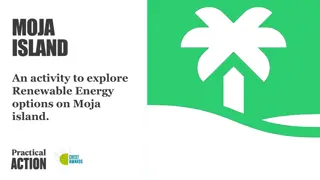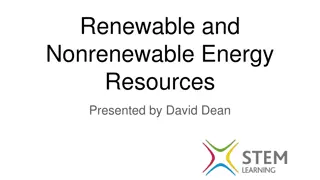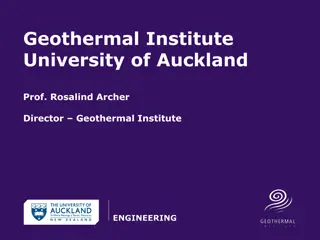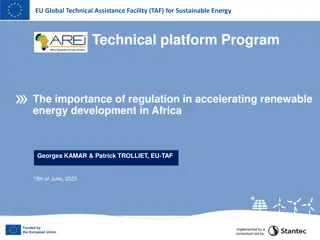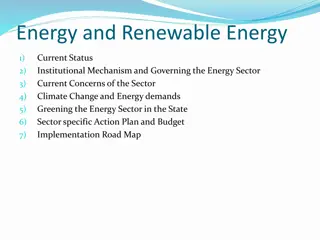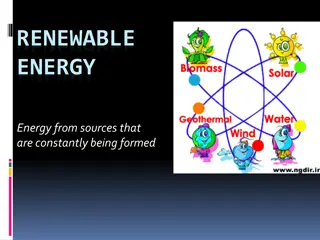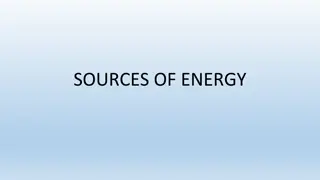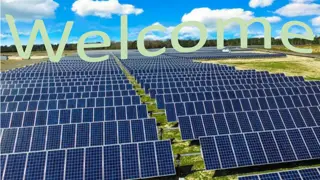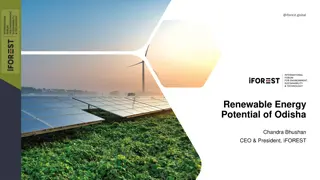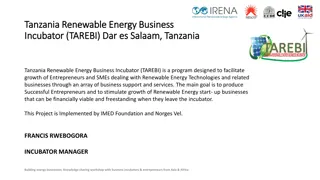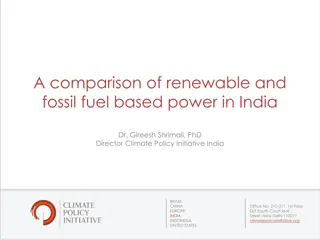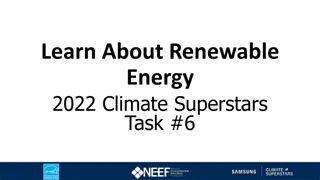Effective Regulation of Active Power in Renewable Energy Sources
The balance between generation and load is crucial in power systems operation. Various control levels ensure this balance, from frequency control to power station planning. DER units may lack control means, but specific configurations allow for frequency and voltage control. Performance indicators and DER penetration influence hosting capacity and system stability. Frequency Quality Control is essential for maintaining balance under different operational conditions. Primary, secondary, and tertiary control actions play key roles in managing frequency deviations. Automatic generator output adjustments through secondary control are necessary due to continuous load changes.
Download Presentation

Please find below an Image/Link to download the presentation.
The content on the website is provided AS IS for your information and personal use only. It may not be sold, licensed, or shared on other websites without obtaining consent from the author.If you encounter any issues during the download, it is possible that the publisher has removed the file from their server.
You are allowed to download the files provided on this website for personal or commercial use, subject to the condition that they are used lawfully. All files are the property of their respective owners.
The content on the website is provided AS IS for your information and personal use only. It may not be sold, licensed, or shared on other websites without obtaining consent from the author.
E N D
Presentation Transcript
Regulacija uestanosti i aktivnih snaga pomo u obnovljivih izvora energije
The balance between generation and load is one of the basic requirements of the operation of power systems. Different levels of control are in use to guarantee this balance: ranging from the primary frequency control at a timescale of seconds through the planning of power stations at a timescale of several years. The DER units mostly are not equipped with control means, but for some specific DER configurations frequency and voltage control facilities can be introduced.
For each relevant operational issue one or more performance indicators will be defined as well as a limit for what is acceptable. The value of the performance indicator will be calculated as a function of the DER penetration level. The hosting capacity is obtained as the penetration level for which the performance index exceeds its limit. The influence of different types of DER to the possible limit of secure operation for interconnected power system is an important issue. The impact of small but increasing levels of DER penetration on the performance of primary, secondary and tertiary control was studied. The final aim is to find the maximal limit of DER penetration beyond which the loss of stability of the power system control takes place.
Frequency Quality Control Requirements for Different Operational Conditions Within a given control area, load demand should be covered at all times by electricity produced in that area, together with electricity imports. In order to maintain this balance, reserve generating capacity should be available to cover power plant outages and any disturbances effecting generation, demand and transmission. Under undisturbed conditions, the network frequency must be maintained within strict limits in order to ensure operation of control facilities in response to a disturbance. The various disturbances in a power system will cause frequency deviation in the network. Control facilities, which prevent frequency deviation and allow keeping it within strict limits, are primary, secondary and tertiary control. Primary control involves the action of turbine speed governors of generating units, which will respond during the frequency deviation from the frequency set point as a result of imbalance between generation and demand in the network. It aim is to prevent deep power system frequency decline.
With primary frequency control action, a change in system load will result in a steady- state frequency deviation, depending on the governor droop characteristic and frequency sensitivity of the load. All generating units will contribute to the overall change in generation, irrespective of the location of the load change. Restoration of system frequency to nominal value requires supplementary control action, which adjusts the load reference set point. As system load is continually changing, it is necessary to change the output of generators automatically. This is done by so called secondary control.
The function of secondary control in a given control area is as follows: the maintenance of scheduled power exchange program between the areas and all other interconnected zones; the secondary control reserve will only be activated in the control area where the imbalance appeared; the restoration of the synchronous system frequency to its set point value. In some countries functions of secondary control fulfill centralized control system automatic generation control (AGC). The primary objectives of automatic generation control are to regulate frequency to the specified nominal value and to maintain the interchange power between control areas at the scheduled values.
Tertiary control is any automatic or manual change in the output powers set points of generators, participating in secondary control, in order to: guarantee the provision of an adequate secondary control reserve at the right time; distribute the secondary control power to various generators in the best possible way, in terms of economical considerations.
Control Performance Standards This standard is implemented in North America. Control Performance Standards (CPS) takes as an objective to ensure frequency stability and accuracy. The consecutive quality criteria aim at keeping the frequency standard deviation bounded and lower than agreed limit. Since February 1997, Control performance Standards CPS have been implemented in North America.
CPS1 Indicator For a given Control Area, the CPS1 criterion processes the measures of power imbalance and frequency deviation, and as a result checks the compliance of power exchanges with a predefined reference. Power imbalances give an image of the ability of a Control Area to match its generation with the variations of its own consumption and support the system frequency quality. CPS1 indicator converts a compliance ratio to a percentage level representative of the control impact on frequency: The computation of the CPS1 indicator needs in a first step the computation of the Compliance Factor CF given by:
Where: AVG average; ACE Measured Area Control Error; B - Estimated Frequency bias coefficient of a Control Area expressed in MW/0.1 Hz f - Frequency deviation; - system constant equal to the Root Mean Square of one-minute average frequency error over a given year (18 23 mHz). A Control Area LFC is declared to have a suitable action on the system frequency if CPS1 indicator satisfies the following condition:
CPS2 indicator CPS2 has been designed to fulfill the objective of bounding unscheduled power flows. It states that every Control Area has to comply with the condition: Where Ld is the chosen limit of the ten-minute ACE average.
Emergency operational conditions In an extremely complex and highly integrated power system disturbances may be propagated over a vast area within a very short time period. Experience has shown that, in this type of situation, even a simple incident can degenerate extremely rapidly into large-scale blackouts. Imperfection of emergency automation control systems was the main reason of blackouts happened in 2002 and 2003. Fig.2.1 illustrates frequency behavior during the blackout in Italy on 28 September 2003. For about 2 minutes slow frequency decline took place and than frequency avalanche caused complete system collapse. Network operators need to apply any measures required to ensure that, so far as possible, the consequences of initial incidents will be contained within the frontiers of their respective area of operation. There are no common standards for preventing of deep frequency decline, caused by a large generating power deficiency. Under-frequency and over-frequency situations are treated in each power system differently.
There are two main problems associated with the operation of power system at a low frequency, both related to thermal generating units. The first problem is concerned with the vibratory stresses on the long low-pressure turbine blades. Sustained operation within the band 59.5 Hz to 60 Hz (for the USA power systems) would not have any effect on blade life, while the area below 59.5 Hz is area of restricted time operating frequency limits. When frequency is below 56 Hz turbines should be disconnected from network instantaneously. In Western Europe the minimum frequency is 47.5 Hz unit delayed trip and 47 Hz instantaneous trip. This is related to behavior of large steam turbines. Since the effects of vibratory stress are cumulative with time restoration of normal frequency keeping frequency in allowed frequency-time zone is essential (see Fig.2.2.). For different countries and turbines manufactures allowed frequency-time zones can be different.
The second problem is concerned with the performance of plant auxiliaries driven by induction motors. At low frequencies the plant capability may be severely reduced because of the reduced output of boiler feed pumps or fans supplying combustion air or water to boilers. This is also dangerous for consumers having rotating load, fans and pumps.
Deep frequency decline can be prevented either by increasing output mechanical torques of the turbines or by decreasing the load power. The first approach is not acceptable due to the slow reaction of turbine governor. Logical solution is to shed part of the load on under-frequency situation. Frequency actuated load shedding systems are the common type of under-frequency emergency automation. In case of a major frequency drop, automatic devices for load shedding in response to a frequency criterion must shed part of the system load.
Controllability of DER types associated with the frequency control Introduction There s many reasons promoting the implementation of distributed energy resources (DER), such as the creation of new business and employment opportunities, countermeasure to global warming and reduction of dependence on fossil fuels, to name a few. Thanks to factors like these, the proportion of DER on power systems has increased. At the same time DER are characterized by low inertias, high reactances, short time constants and poor inherent damping. In most cases they are equipped with basic AVR s and are connected to distribution networks with protection operating times often in excess of the critical fault clearing time of generators. DER units mostly are not equipped with frequency control as well. That s why the impact of DER on power systems should be investigated. Among other things the controllability of DER types associated with the frequency control should be noticed. Frequency stability in electrical networks is essential for maintaining security of supply. It has been suggested that stability requirements may limit the level of penetration of DER in general and intermittent renewable energy in particular.
Frequency control of intermittent types of DER There is a wide range of types of DER: small hydro, solar, wind power plants; CHP; diesel engine, micro-turbine, fuel cell powered generation sources, for example. It is essential from the point of view of frequency regulation to divide the different types of DER into two main groups the intermittent and non-intermittent ones. The intermittent types of DER - wind and solar power plants will be first analyzed regarding to frequency control.
Wind power plants. Background information concerning frequency and active power regulation Commercial wind turbines range in size from a few kW to about 3.5 MW. Wind turbines in the range 4-5 MW exist in prototype stage. Single wind turbines and small wind farms up to a few MW are connected to the distribution grid. Larger wind farms are connected to higher voltage levels. Characteristics that define the different wind turbine technologies are: Fixed or variable blade angle. Fixed or variable generator speed. Induction or synchronous generator. Converter or no converter. Gearbox or no gearbox.
In fixed-speed wind turbines the generator (usually a squirrel cage induction generator) is directly connected to the power grid and its rotor is mechanically coupled to the turbine rotor through a fixed-ratio gearbox. In this case, the primary torque variations, due to the wind speed fluctuations, cause high oscillations in the injected active power and stability and power quality problems may arise. In order to avoid these problems, variable pitch angle turbines can be used, but even with a good control pitch angle scheme, the time constants of the mechanical systems are in the range of milliseconds and, if the wind speed varies rapidly, high power swings may still occur and affect the power system quality. The control is presently only possible with variable speed wind turbine above nominal wind speed of the order 12 m/s. It requires that a control margin is set. This reduces the economic efficiency of the investment. This is could change if primary energy is getting more expensive. If the experience is characterized by wind speed below 12 m/s, this type of control could be seldom used. Further modifications in terms of control are necessary for making wind turbines able to participate to power frequency control.
Adjustable-speed wind generation systems use synchronous or squirrel cage induction machine with the stator connected to the grid through an AC/DC/AC converter or doubly fed induction generator which rotor is connected to the grid via the converter while the stator is directly connected to the power system. In this last case, better efficiency due to lower losses in the switches and the lower cost of the converter and filter are the main advantages. Advantages over fixed- speed wind turbines include reduced mechanical stress, improved power system quality and stability and higher efficiency, for example. In addition to fixed-speed and adjustable-speed systems, there are some varieties. One that should be mentioned is the semi-variable system. In this system, a squirrel cage induction generator, with the capability to change the rotor resistance by means of power electronics, is used. In this way, a transient rotor speed increase of 10% of the nominal rotor speed is possible for emergency situation. Therefore, a variable rotor speed capability is achieved in a relatively low cost.
Different systems with synchronous generators are also used. The three most common wind turbine designs are: Stall controlled, constant speed wind turbine with induction generator. Pitch controlled, variable speed wind turbine with doubly fed induction generator. Pitch controlled variable speed wind turbine with direct drive synchronous generator. This implementation has been set up for power quality question and stability in case of system fault, not for efficiency as the speed control is implemented by increasing Joule losses in the rotor circuit.
Conclusions No frequency control system is used in any type of wind power plant for grid- connected operation under normal and emergency conditions. The power output from wind power plants depends on variable wind energy thus burdening frequency and active power regulation for regulating power plants. Complicated and expensive converter systems should be used to reduce within the limits of possibility the output power deviations from wind power plants. Extra difficulties appear as a result of possible mismatch between wind power plant output and consumed power. There is a need in additional generation reserve, which would cover deviations in wind power plant output.
The most relevant aspects influencing hosting capacity of wind power plants Power reserves for wind power plants output fluctuation Wind power plants should be 100% reserved by conventional power plants as though the output power depends on the inconsistent nature of wind. When there is no wind, wind power plants even consume electric power.
Lack of wind (wind speed less than 3,54 m/s) can cover large territories. For example, in West Denmark, there were 54 days in 2002 when wind supplied less than 1% of demand. One day (16 August) there was negative output as the wind power system steering requirements exceeded wind output . Also February 2003 was cold but relatively windless.
Increase of active power and frequency swings in power system The larger proportion of wind power plants in a power system, the larger are active power and frequency swings in it in case of change of wind speed. For example, in West Denmark, the small difference in wind speed of just one meter per second amounts to a difference in output (rise or fall) of 320 MW.
Figure illustrates another example of the wind power infeed pattern. In the E.ON territory (Germany) during a week with strong winds the difference between minimum and maximum infeed in this example was over 4,300 MW equivalent to the capacity of six to eight large coal-fired power station blocks
It must be noticed, that the wind power infeed changes can occur in a relatively short time. This can be seen in the following figure, which shows the wind power infeed pattern in the E.ON control area in the week of 17th to 23rd November 2003. It is clear that on 19th November, the wind power infeed dropped very sharply by 3,640 MW within six hours, with an average value of 10 MW per minute.
Problems with forecasting Unpredictable nature of wind burdens forecasting. The chart in figure illustrates a bad day for Danish weather forecasts. This is not exceptional.
Large quantities of electrical energy cannot be directly stored. This means that every second, exactly the amount of energy must be fed into the grid that is taken out at the same time. If the amount fed in differs from the amount tapped of, this can cause faults or even failure of the supply as confirmed in 2003 by the wide-scale power failures in the USA, Italy, Sweden and Denmark. The transmission system operators must therefore at all times ensure a balance in their control areas between generation and tapping (power-frequency control). However, the increased use of wind power, for example, in Germany has resulted in uncontrollable fluctuations now also occurring on the generation side due to the stochastic character of wind power infeed, thereby increasing the demands placed on control and bringing about rising grid costs .
Difference between generated wind power and load consumption charts Wind is inconsistent and wind power plants may change their output contrary to demand
Load factor of wind power plants It should be noted, that average power output from wind power plant is lower than the installed capacity. It is defined by load factor. Load factor is the proportion of actual output of wind turbines compared to installed capacity. For example, in 1999 these were: Best -- Spain at 27.8% Worst -- Finland 14.8% European average -- 19.5% UK load factors were: 1995 -- 21.5% 1996 -- 21.9% 1997 -- 23.9% 1998 -- 28.6% Four year average -- 24%
Situation in E.ON control area is shown figure. Looked at over the course of the year, as the annual wind infeed curve shows the availability of the installed wind power plants was relatively low. Simultaneous wind power infeed was maximum 4,980 MW, equivalent to just under 80 % of the installed capacity. The average fed-in capacity was less than one sixth of the wind power capacity installed in the yearly average. Over half the year, the wind power fed-in was less than 11% of the wind power capacity installed in the yearly average. To depict the annual curve, the respective wind power is determined for each quarter-hour of a year and is then shown from left to right in a diagram in descending order based on the wind power level. If we observe a point on the curve, the associated quarter-hour value (horizontal axis) states how many quarter-hours in the year the wind power plants fed in at least the power that can be read off on the vertical axis. For the remainder of the year, generation was below this power value.
Solar power plants Background information concerning frequency and active power regulation A schematic diagram of a grid connected photovoltaic system is shown in Figure. The photovoltaic array is assembled from a number of parallel and/or series photovoltaic modules (the smallest commercially available unit), in order to match the needs for power of the project and the voltage thresholds of the inverter. Because the photovoltaic array produces dc power the inverter is needed for the interface with the public grid. The control system implements all the main control and protection functions, including Maximum Power Point Tracking (MPPT), protection relay and detection of islanding operation.
The dc power output of a photovoltaic array depends on which point in the V-I curve it is working at. Ideally, it should operate at the maximum power point (MPP) of the curve. The MPP is variable throughout the day, mainly as a function of environmental conditions such as irradiance and temperature, but inverters directly connected to PV arrays have an MPP tracking algorithm to maximize energy transfer. An important issue of MPP algorithms is the cycle time for their execution. If this time is fast, something that can be justified from the fact that no moving parts take part in this process, then for power system studies it can be assumed that the response of MPP algorithm is instantaneous and as a result it can be considered that the photovoltaic array operates always at the MPP. However if the time cycle of the MPP algorithm execution is relatively slow, then the algorithm should be considered in power system simulation studies.
Efficiency of the photovoltaic modules depends on the materials and manufacturing process used. Most of the solar energy that is not converted into electricity in the photovoltaic module is absorbed as heat. As the temperature of the photovoltaic module increases, the maximum efficiency will decrease. Efficiency of the photovoltaic modules decreases on windy or cloudy days, and is better on sunny days. Table presents a summary of test results:
In common with wind power, the solar irradiation is inconsistent. Figure illustrates solar irradiation in cloudy (march 11) and sunny (march 12) days:
Conclusions No frequency control system is used in solar power plants for grid-connected operation under normal and emergency conditions. Smoother output power is obtained by the help of Maximum Power Point Tracking control system. The power output from solar power plants depends on inconsistent solar irradiance thus burdening frequency and active power regulation for regulating power plants. In comparison with wind power plant, output power is smoother. Extra difficulties appear as a result of possible mismatch between solar power plant output and consumed power. There is a need in additional generation reserve, which could cover deviations in solar power plant output.
The most relevant aspects influencing hosting capacity of solar power plants Reserving of solar power plants output power Solar power plants should be 100% reserved by conventional power plants as though the output power depends on the inconsistent solar irradiation. Thunderstorms, for example, are rather unpredictable and power output from solar power plants significantly decreases during them. During the dark time (at night, late evening or morning) no power output from solar power plants is obtained.
Increase of active power and frequency swings in power system Inconsistent nature of solar irradiation inevitably increases active power and frequency swings in power system, however the rate of change of solar irradiation is less than the rate of change of wind speed, especially in sunny days. Figure illustrates example of solar irradiance during a sunny and a cloudy day.
Problems with forecasting In comparison with wind resources, solar irradiance is somewhat less inconsistent and easier to forecast. Difference between generated solar irradiation and load consumption charts Likewise to wind speed, solar irradiation is inconsistent and solar power plants may change their output contrary to demand. For example, HECO peak demand occurs in the 6-7 p.m. hour on most days. There is little or no sunshine at that time in Hawaii, especially in the winter. Load factor of solar power plants Average power output from wind power plant is lower than the installed capacity, however the load factor is somewhat higher than in the case of wind power plants. Inefficiency of solar power plants in frequency regulation Solar power plants do not take part in frequency and active power regulation.
Frequency control of non-intermittent types of DER These types of DER do not depend on intermittent natural resources such as wind or solar irradiation and can have enough fuel on site or accumulate it as in case of small hydro power plants. Most of them can adjust mechanical power input in order to maintain a constant frequency. Non-intermittent types of DER small hydro power plants; CHP; fuel cell, micro- turbine and diesel generator powered energy sources will be further analyzed regarding to frequency control.
Small hydro power plants (SHP) Background information concerning frequency and active power regulation There is no general international consensus on the definition of small hydro power. The upper power-limit varies from 2.5 to 25 MW, according to the country, but 10MW is becoming generally accepted and has been adopted by ESHA (The European small-hydro Association). There are two basic types of generators used in small-hydro plants, synchronous or induction generators. In SHP power plants up to 2-3 MW, induction generators are normally used if the grid conditions do not require the plant to operate on its own grid. For SHP-plants in the range of 3-10 MW, synchronous generators are normally used. Considering the weak rated powers of the small hydro, the rated voltage of the generators is situated in the low voltage or medium voltage ranges. Small hydro generation is characterized by its reliability and flexibility of operation, including fast start-up and shutdown in response to rapid changes in demand. Small hydro will give a contribution of energy, which can be dispatched into the electricity system even if the production will be decreased during dry periods of the year. Energy obtained will be limited to the amount of existing hydraulic resource. Thus for the Latvian experience at a dry season amount of water in the small rivers can be close to zero.
SHP can take part in frequency regulation if generator is equipped with a speed governor. The basic function of a governor is to control speed and/or load. In order to ensure satisfactory and stable parallel operation of multiple units, the speed governor is provided with a droop characteristic. For a hydro turbine, however, such a governor with a simple steady-state droop characteristic would be unsatisfactory. Hydro turbines have a peculiar response due to water inertia. For stable control performance, a large transient (temporary) droop with a long resetting time is required. The result is a governor, which exhibits a high droop (low gain) for speed deviations, and the normal low droop (high gain) in the steady state. Conclusions SHP mostly are not equipped with the frequency control, however it is possible to react on frequency changes and to help in active power and frequency regulation if generator is equipped with speed governor. There are some seasonal periods when water inlet of the small rivers is minimal and, hence, participation in frequency control is limited.
Combined heat and power plants (CHP) The CHP can be divided by level of electrical generation output as described in the Table, where only up to 10 MW CHP generation is described, which is assumed as DER generation.
The prime mover identifies the CHP system. Natural gas is the most common fuel, but there are prime movers capable of burning other fuels like coal, oil, or other alternative fuels such as biomass. So CHP as generating unit is typical heat engine with standard type of generator and predictable load. In case synchronous generator with speed governor system is used it is possible to use CHP system for frequency control. Conclusion CHP can successfully contribute to active power and frequency control.
Fuel Cells powered energy sources Fuel cells are an important technology for a potentially wide variety of applications including micro-power, auxiliary power, transportation power, stationary power for buildings and other distributed generation applications, and central power [20, 23]. A fuel cell produces a current in the range of 1500-3000 A/m2 of cell area depending on operating temperature and pressure. A typical operating voltage range of fuel cell is about 0.6 to 0.75 Volts. This is equivalent to 900-1800 W/m2 of cell area in the fuel cell. Groups of fuel cells may be connected in series/parallel combinations, to form the fuel cell stack and to provide the desired output. Fuel cells are being developed in the size range of a few kilowatts up to a few megawatts. However, larger units (up to 20 MW), and smaller micro-fuel cells (for portable electronic devices) are also being investigated. Typical power ranges are collected in table.
Output voltage depends on the cell voltage and the number of cells in series. Main energy source of fuel cells is the hydrogen. Different technologies for hydrogen production and storage exist. As far as hydrogen is available, the fuel cell output is controllable and can be programmed. Starting time depends on the type and operating temperature of fuel cell. Low- temperature operated fuel cells allow a fast startup with improved dispatch-ability. About 50% of maximum power is available immediately at room temperature, whereas full operating power is available within about 3 minutes under normal conditions. High-temperature operated fuel cells require a significant start-up time (hours) and a worse dispatch-ability. In general fuel cells are capable of operating independent from the grid and can help in the restoration of the power system. Conclusion Fuel cell can contribute to active power and frequency control in case its design offers ability to fulfill frequency control requirements.
Micro-turbine powered energy sources Micro-turbine technological cycle is similar to steam operated turbine unit. Micro-turbines can be used for power generation ranging from about 25 kW to 500 kW. Small micro-turbines (up to 200 kW) are a more mature technology, micro- turbines over 200 kW are still experiencing strong development. The power electronics package of a micro-turbine converts the output of the high- speed generator from 120-600V to the required voltage level depending on country location. Most common energy source of micro-turbines is the natural gas, which can be obtained from the fuel s large distribution networks. Controlling the feed of the micro- turbine, the needed power output can be obtained; therefore the source is not fluctuating and can be programmed.
The performance test on the micro-turbine indicates that the unit has slow startup and shutdown capabilities, requiring several minutes. However, once up and operating, the unit can vary (dispatch) its power output level within tens of seconds once a new power setting is selected. Conclusion However most micro-turbines do not have governors it is possible for them to react on frequency changes and to help in active power and frequency regulation.







